Physical and Biomechanical Relationships with Countermovement Jump Performance in Team Sports: Implications for Athletic Development and Injury Risk
Abstract
1. Introduction
2. Materials and Methods
2.1. Study Design
2.2. Search Strategy
2.3. Eligibility Criteria
2.4. Study Selection
2.5. Assessment of Reporting Quality
2.6. Data Extraction
2.7. Categorization and Presentation of Findings
2.8. Statistical Analyses
3. Results
3.1. Selection of Studies
3.2. Assessment of Reporting Quality
3.3. Participant Characteristics
3.4. Intervention Characteristics
3.5. CMJ Performance Characteristics
3.5.1. Anthropometric and Morphological Characteristics
3.5.2. Strength Characteristics
3.5.3. Power Characteristics
3.5.4. COD and Sprint Characteristics
3.5.5. Global CMJ Characteristics
3.5.6. CMJ Joint-Related Characteristics
4. Discussion
4.1. Anthropometric and Morphological Characteristics
4.2. Strength, Power, COD, and Sprint Characteristics
4.3. Global CMJ Characteristics
4.4. CMJ Joint-Related Characteristics
4.5. Limitations
4.6. Practical Applications
5. Conclusions
Supplementary Materials
Author Contributions
Funding
Data Availability Statement
Conflicts of Interest
References
- Kellis, S.E.; Tsitskaris, G.K.; Nikopoulou, M.D.; Mousikou, K.C. The evaluation of jumping ability of male and female basketball players according to their chronological age and major leagues. J. Strength Cond. Res. 1999, 13, 40–46. [Google Scholar]
- Rodríguez-Rosell, D.; Mora-Custodio, R.; Franco-Márquez, F.; Yáñez-García, J.M.; González-Badillo, J.J. Traditional vs. sport-specific vertical jump tests: Reliability, validity, and relationship with the legs strength and sprint performance in adult and teen soccer and basketball players. J. Strength Cond. Res. 2017, 31, 196–206. [Google Scholar] [CrossRef]
- Sheppard, J.M.; Cronin, J.B.; Gabbett, T.J.; McGuigan, M.R.; Etxebarria, N.; Newton, R.U. Relative importance of strength, power, and anthropometric measures to jump performance of elite volleyball players. J. Strength Cond. Res. 2008, 22, 758–765. [Google Scholar] [CrossRef]
- Talpey, S.; Smyth, A.; O’Grady, M.; Morrison, M.; Young, W. The occurrence of different vertical jump types in basketball competition and their relationship with lower-body speed-strength qualities. Int. J. Strength Cond. 2021, 1, 1–7. [Google Scholar] [CrossRef]
- Taylor, J.B.; Wright, A.A.; Dischiavi, S.L.; Townsend, M.A.; Marmon, A.R. Activity demands during multi-directional team sports: A systematic review. Sports Med. 2017, 47, 2533–2551. [Google Scholar] [CrossRef] [PubMed]
- Hughes, S.; Warmenhoven, J.; Haff, G.G.; Chapman, D.W.; Nimphius, S. Countermovement jump and squat jump force-time curve analysis in control and fatigue conditions. J. Strength Cond. Res. 2022, 36, 2752–2761. [Google Scholar] [CrossRef] [PubMed]
- Kons, R.L.; Ache-Dias, J.; Detanico, D.; Barth, J.; Dal Pupo, J. Is vertical jump height an indicator of athletes’ power output in different sport modalities? J. Strength Cond. Res. 2018, 32, 708–715. [Google Scholar] [CrossRef] [PubMed]
- Markovic, S.; Mirkov, D.M.; Nedeljkovic, A.; Jaric, S. Body size and countermovement depth confound relationship between muscle power output and jumping performance. Hum. Mov. Sci. 2014, 33, 203–210. [Google Scholar] [CrossRef]
- Morrison, M.; Martin, D.T.; Talpey, S.; Scanlan, A.T.; Delaney, J.; Halson, S.L.; Weakley, J. A systematic review on fitness testing in adult male basketball players: Tests adopted, characteristics reported and recommendations for practice. Sports Med. 2022, 52, 1491–1532. [Google Scholar] [CrossRef]
- Theodorou, A.S.; Rizou, H.-P.; Zacharakis, E.; Ktistakis, I.; Bekris, E.; Panoutsakopoulos, V.; Strouzas, P.; Bourdas, D.I.; Kostopoulos, N. Pivot step jump: A new test for evaluating jumping ability in young basketball players. J. Funct. Morphol. Kinesiol. 2022, 7, 116. [Google Scholar] [CrossRef]
- Brocherie, F.; Girard, O.; Forchino, F.; Al Haddad, H.; Dos Santos, G.A.; Millet, G.P. Relationships between anthropometric measures and athletic performance, with special reference to repeated-sprint ability, in the Qatar national soccer team. J. Sports Sci. 2014, 32, 1243–1254. [Google Scholar] [CrossRef]
- Chiu, L.Z.F.; Bryanton, M.A.; Moolyk, A.N. Proximal-to-distal sequencing in vertical jumping with and without arm swing. J. Strength Cond. Res. 2014, 28, 1195–1202. [Google Scholar] [CrossRef] [PubMed]
- Swinton, P.A.; Lloyd, R.; Keogh, J.W.L.; Agouris, I.; Stewart, A.D. Regression models of sprint, vertical jump, and change of direction performance. J. Strength Cond. Res. 2014, 28, 1839–1848. [Google Scholar] [CrossRef]
- Miller, J.D.; Fry, A.C.; Ciccone, A.B.; Poggio, J. Analysis of rate of force development as a vertical jump height predictor. Res. Q. Exerc. Sport. 2023, 94, 638–645. [Google Scholar] [CrossRef] [PubMed]
- Pocek, S.; Milosevic, Z.; Lakicevic, N.; Pantelic-Babic, K.; Imbronjev, M.; Thomas, E.; Bianco, A.; Drid, P. Anthropometric characteristics and vertical jump abilities by player position and performance level of junior female volleyball players. Int. J. Env. Res. Public. Heal. 2021, 18, 8377. [Google Scholar] [CrossRef]
- Huovinen, H.T.; Hulmi, J.J.; Isolehto, J.; Kyröläinen, H.; Puurtinen, R.; Karila, T.; Mackala, K.; Mero, A.A. Body composition and power performance improved after weight reduction in male athletes without hampering hormonal balance. J. Strength Cond. Res. 2015, 29, 29–36. [Google Scholar] [CrossRef]
- Merrigan, J.J.; Rentz, L.E.; Hornsby, W.G.; Wagle, J.P.; Stone, J.D.; Smith, H.T.; Galster, S.M.; Joseph, M.; Hagen, J.A. Comparisons of countermovement jump force-time characteristics among national collegiate athletic association division I American football athletes: Use of principal component analysis. J. Strength Cond. Res. 2022, 36, 411–419. [Google Scholar] [CrossRef] [PubMed]
- Earp, J.E.; Kraemer, W.J.; Cormie, P.; Volek, J.S.; Maresh, C.M.; Joseph, M.; Newton, R.U. Influence of muscle–tendon unit structure on rate of force development during the squat, countermovement, and drop jumps. J. Strength Cond. Res. 2011, 25, 340–347. [Google Scholar] [CrossRef]
- Earp, J.E.; Kraemer, W.J.; Newton, R.U.; Comstock, B.A.; Fragala, M.S.; Dunn-Lewis, C.; Solomon-Hill, G.; Penwell, Z.R.; Powell, M.D.; Volek, J.S.; et al. Lower-body muscle structure and its role in jump performance during squat, countermovement, and depth drop jumps. J. Strength Cond. Res. 2010, 24, 722–729. [Google Scholar] [CrossRef]
- Xie, T.; Crump, K.B.; Ni, R.; Meyer, C.H.; Mart, J.M.; Blemker, S.S.; Feng, X. Quantitative relationships between individual lower-limb muscle volumes and jump and sprint performances of basketball players. J. Strength Cond. Res. 2020, 34, 623–631. [Google Scholar] [CrossRef]
- García-Valverde, A.; Manresa-Rocamora, A.; Hernández-Davó, J.L.; Sabido, R. Effect of weightlifting training on jumping ability, sprinting performance and squat strength: A systematic review and meta-analysis. Int. J. Sports Sci. Coach. 2022, 17, 917–939. [Google Scholar] [CrossRef]
- Malyszek, K.K.; Harmon, R.A.; Dunnick, D.D.; Costa, P.B.; Coburn, J.W.; Brown, L.E. Comparison of Olympic and hexagonal barbells with midthigh pull, deadlift, and countermovement jump. J. Strength Cond. Res. 2017, 31, 140–145. [Google Scholar] [CrossRef]
- Weakley, J.J.S.; Till, K.; Read, D.B.; Leduc, C.; Roe, G.A.B.; Phibbs, P.J.; Darrall-Jones, J.; Jones, B. Jump training in rugby union players: Barbell or hexagonal bar? J. Strength Cond. Res. 2021, 35, 754–761. [Google Scholar] [CrossRef]
- Boraczyński, M.; Boraczyński, T.; Podstawski, R.; Wójcik, Z.; Gronek, P. Relationships between measures of functional and isometric lower body strength, aerobic capacity, anaerobic power, sprint and countermovement jump performance in professional soccer players. J. Hum. Kinet. 2020, 75, 161–175. [Google Scholar] [CrossRef] [PubMed]
- Carlock, J.M.; Smith, S.L.; Hartman, M.J.; Morris, R.T.; Ciroslan, D.A.; Pierce, K.C.; Newton, R.U.; Harman, E.A.; Sands, W.A.; Stone, M.H. The relationship between vertical jump power estimates and weightlifting ability: A field-test approach. J. Strength Cond. Res. 2004, 18, 534–539. [Google Scholar] [PubMed]
- Rogers, T.; Gill, N.; Watkins, C.; Beaven, C.M. Relationship of a six-second peak power cycle ergometer test with maximal and ballistic strength tests in international rugby union players. Int. J. Strength Cond. 2024, 4. [Google Scholar] [CrossRef]
- Merino-Muñoz, P.; Vidal-Maturana, F.; Aedo-Muñoz, E.; Villaseca-Vicuña, R.; Pérez-Contreras, J. Relationship between vertical jump, linear sprint and change of direction in Chilean female soccer players. J. Phys. Educ. Sport. 2021, 21, 2737–2744. [Google Scholar]
- Suarez-Arrones, L.; Gonzalo-Skok, O.; Carrasquilla, I.; Asián-Clemente, J.; Santalla, A.; Lara-Lopez, P.; Núñez, F.J. Relationships between change of direction, sprint, jump, and squat power performance. Sports 2020, 8, 38. [Google Scholar] [CrossRef]
- Carr, C.; McMahon, J.J.; Comfort, P. Relationships between jump and sprint performance in first-class county cricketers. J. Trainology 2015, 4, 1–5. [Google Scholar] [CrossRef]
- Cronin, J.B.; Hansen, K.T. Strength and power predictors of sports speed. J. Strength Cond. Res. 2005, 19, 349–357. [Google Scholar] [PubMed]
- Dobbs, C.W.; Gill, N.D.; Smart, D.J.; McGuigan, M.R. Relationship between vertical and horizontal jump variables and muscular performance in athletes. J. Strength Cond. Res. 2015, 29, 661–671. [Google Scholar] [CrossRef]
- Wheeler Botero, C.; Patiño Palma, B.E.; Ramos-Parrací, C.; Gomez-Rodas, A. Vertical jump performance and the relationship with sprint speed at 20 m and 50 m in professional soccer players. F1000Research 2023, 12, 663. [Google Scholar] [CrossRef]
- González-Badillo, J.J.; Marques, M.C. Relationship between kinematic factors and countermovement jump height in trained track and field athletes. J. Strength Cond. Res. 2010, 24, 3443–3447. [Google Scholar] [CrossRef] [PubMed]
- Harry, J.R.; Barker, L.A.; Tinsley, G.M.; Krzyszkowski, J.; Chowning, L.D.; McMahon, J.J.; Lake, J. Relationships among countermovement vertical jump performance metrics, strategy variables, and inter-limb asymmetry in females. Sports Biomech. 2024, 23, 1009–1027. [Google Scholar] [CrossRef] [PubMed]
- McErlain-Naylor, S.; King, M.; Pain, M.T.G. Determinants of countermovement jump performance: A kinetic and kinematic analysis. J. Sports Sci. 2014, 32, 1805–1812. [Google Scholar] [CrossRef]
- McMahon, J.J.; Jones, P.A.; Suchomel, T.J.; Lake, J.; Comfort, P. Influence of the reactive strength index modified on force-and power-time curves. Int. J. Sports Physiol. Perform. 2018, 13, 220–227. [Google Scholar] [CrossRef]
- Vanezis, A.; Lees, A. A biomechanical analysis of good and poor performers of the vertical jump. Ergonomics 2005, 48, 1594–1603. [Google Scholar] [CrossRef]
- Guess, T.M.; Gray, A.D.; Willis, B.W.; Guess, M.M.; Sherman, S.L.; Chapman, D.W.; Mann, J.B. Force-time waveform shape reveals countermovement jump strategies of collegiate athletes. Sports 2020, 8, 159. [Google Scholar] [CrossRef]
- Amasay, T.; Suprak, D.N. Predicting time to take-off in a countermovement jump for maximal quickness from upright and squat starting positions. J. Hum. Kinet. 2022, 84, 53–63. [Google Scholar] [CrossRef]
- Johnston, L.A.; Butler, R.J.; Sparling, T.L.; Queen, R.M. A single set of biomechanical variables cannot predict jump performance across various jumping tasks. J. Strength Cond. Res. 2015, 29, 396–407. [Google Scholar] [CrossRef]
- Rauch, J.; Leidersdorf, E.; Reeves, T.; Borkan, L.; Elliot, M.; Ugrinowitsch, C. Different movement strategies in the countermovement jump amongst a large cohort of NBA players. Int. J. Env. Res. Public. Heal. 2020, 17, 6394. [Google Scholar] [CrossRef]
- Sole, C.J.; Mizuguchi, S.; Sato, K.; Moir, G.L.; Stone, M.H. Phase characteristics of the countermovement jump force-time curve: A comparison of athletes by jumping ability. J. Strength Cond. Res. 2018, 32, 1155–1165. [Google Scholar] [CrossRef]
- Liberati, A.; Altman, D.G.; Tetzlaff, J.; Mulrow, C.; Gøtzsche, P.C.; Ioannidis, J.P.A.; Clarke, M.; Devereaux, P.J.; Kleijnen, J.; Moher, D. The PRISMA statement for reporting systematic reviews and meta-analyses of studies that evaluate health care interventions: Explanation and elaboration. PLoS Med. 2009, 6, e1000100. [Google Scholar] [CrossRef]
- Page, M.J.; McKenzie, J.E.; Bossuyut, P.M.; Boutron, I.; Hoffmann, T.C.; Mulrow, C.D.; Shamseer, L.; Tetzlaff, J.M.; Akl, E.A.; Brennan, S.E.; et al. The PRISMA 2020 statement: An updated guideline for reporting systematic reviews. Br. Med. J. 2021, 372, n71. [Google Scholar] [CrossRef]
- Pereira, L.A.; Nimphius, S.; Kobal, R.; Kitamura, K.; Turisco, L.A.L.; Orsi, R.C.; Cal Abad, C.C.; Loturco, I. Relationship between change of direction, speed, and power in male and female national Olympic team handball athletes. J. Strength Cond. Res. 2018, 32, 2987–2994. [Google Scholar] [CrossRef]
- Stefanini, M.; Pispero, A.; Del Fabbro, M.; Gobbato, L.; Ghensi, P.; Lodi, G.; Sculean, A.; Zucchelli, G.; Grusovin, M.G. The effect of keratinized mucosa on peri-implant health and patient-reported outcome measures: A systematic review and meta-analysis. Appl. Sci. 2023, 13, 8631. [Google Scholar] [CrossRef]
- Faulks, T.; Sansone, P.; Walter, S. A systematic review of lower limb strength tests used in elite basketball. Sports 2024, 12, 262. [Google Scholar] [CrossRef] [PubMed]
- Hopkins, W.G.; Marshall, S.W.; Batterham, A.M.; Hanin, J. Progressive statistics for studies in sports medicine and exercise science. Med. Sci. Sports Exerc. 2009, 41, 3–12. [Google Scholar] [CrossRef]
- Kipp, K.; Kiely, M.; Giordanelli, M.; Malloy, P.; Geiser, C. Joint- and subject-specific strategies in male basketball players across a range of countermovement jump heights. J. Sports Sci. 2020, 38, 652–657. [Google Scholar] [CrossRef] [PubMed]
- Krzyszkowski, J.; Chowning, L.D.; Harry, J.R. Phase-specific predictors of countermovement jump performance that distinguish good from poor jumpers. J. Strength Cond. Res. 2022, 36, 1257–1263. [Google Scholar] [CrossRef] [PubMed]
- Mikołajec, K.; Gabryś, T.; Gryko, K.; Prończuk, M.; Krzysztofik, M.; Trybek, G.; Maszczyk, A. Relationship among the change of direction ability, sprinting, jumping performance, aerobic power and anaerobic speed reserve: A cross-sectional study in elite 3 × 3 basketball players. J. Hum. Kinet. 2023, 85, 105–113. [Google Scholar] [CrossRef]
- Morris, C.G.; Weber, J.A.; Netto, K.J. Relationship between mechanical effectiveness in sprint running and force-velocity characteristics of a countermovement jump in Australian rules football athletes. J. Strength Cond. Res. 2022, 36, e59–e65. [Google Scholar] [CrossRef] [PubMed]
- Shalfawi, S.A.I.; Enoksen, E.; Tønnessen, E. The relationship between measures of sprinting, aerobic fitness, and lower body strength and power in well-trained female soccer players. Int. J. Appl. Sports Sci. 2014, 26, 18–25. [Google Scholar] [CrossRef]
- Shalfawi, S.A.I.; Sabbah, A.; Kailani, G.; Tønnessen, E.; Enoksen, E. The relationship between running speed and measures of vertical jump in professional basketball players: A field-test approach. J. Strength Cond. Res. 2011, 25, 3088–3092. [Google Scholar] [CrossRef] [PubMed]
- Shinkle, J.; Nesser, T.W.; Demchak, T.J.; McMannus, D.M. Effect of core strength on the measure of power in the extremities. J. Strength Cond. Res. 2012, 26, 373–380. [Google Scholar] [CrossRef]
- Solsu, R.; Özkan, A.; Göktepe, M. The relationship between anaerobic performances, muscle strength, hamstring/quadriceps ratio, agility, sprint ability and vertical jump in professional basketball players. Beden Eğitimi Ve Spor Bilim. Derg. 2016, 10, 164–173. [Google Scholar]
- Frank, A.P.; de Souza Santos, R.; Palmer, B.F.; Clegg, D.J. Determinants of body fat distribution in humans may provide insight about obesity-related health risks. J. Lipid Res. 2019, 60, 1710–1719. [Google Scholar] [CrossRef]
- Ruiz-Cárdenas, J.D.; Rodríguez-Juan, J.J.; Ríos-Díaz, J. Relationship between jumping abilities and skeletal muscle architecture of lower limbs in humans: Systematic review and meta-analysis. Hum. Mov. Sci. 2018, 58, 10–20. [Google Scholar] [CrossRef]
- Riemann, B.L.; Johnson, M.; Helms, M.K.; Hatchett, A.; Vondrasek, J.D.; Watts, C.Q.; Huebner, M. Countermovement jump peak power changes with age in masters weightlifters. Sports 2024, 12, 259. [Google Scholar] [CrossRef]
- Jiménez-Reyes, P.; Samozino, P.; Brughelli, M.; Morin, J.-B. Effectiveness of an individualized training based on force-velocity profiling during jumping. Front. Physiol. 2017, 7, 677. [Google Scholar] [CrossRef]
- McFarland, I.T.; Dawes, J.J.; Elder, C.L.; Lockie, R.G. Relationship of two vertical jumping tests to sprint and change of direction speed among male and female collegiate soccer players. Sports 2016, 4, 11. [Google Scholar] [CrossRef] [PubMed]
- Schiemann, S.; Keiner, M.; Wirth, K.; Lohmann, L.H.; Wagner, C.; Behm, D.G.; Warneke, K. The magnitude of correlation between deadlift 1RM and jumping performance is sports dependent. Front. Sports Act. Living 2024, 6, 1345213. [Google Scholar] [CrossRef] [PubMed]
- Baker, D. Improving vertical jump performance through general, special, and specific strength training: A brief review. J. Strength Cond. Res. 1996, 10, 131–136. [Google Scholar] [CrossRef]
- Porritt, K.; Gomersall, J.; Lockwood, C. JBI’s systematic reviews: Study selection and critical appraisal. Am. J. Nurs. 2014, 114, 47–52. [Google Scholar] [CrossRef]
- Cefai, C.M.; Shaw, J.W.; Cushion, E.J.; Cleather, D.J. An arm swing enhances the proximal-to-distal delay in joint extension during a countermovement jump. Sci. Rep. 2024, 14, 20371. [Google Scholar] [CrossRef] [PubMed]
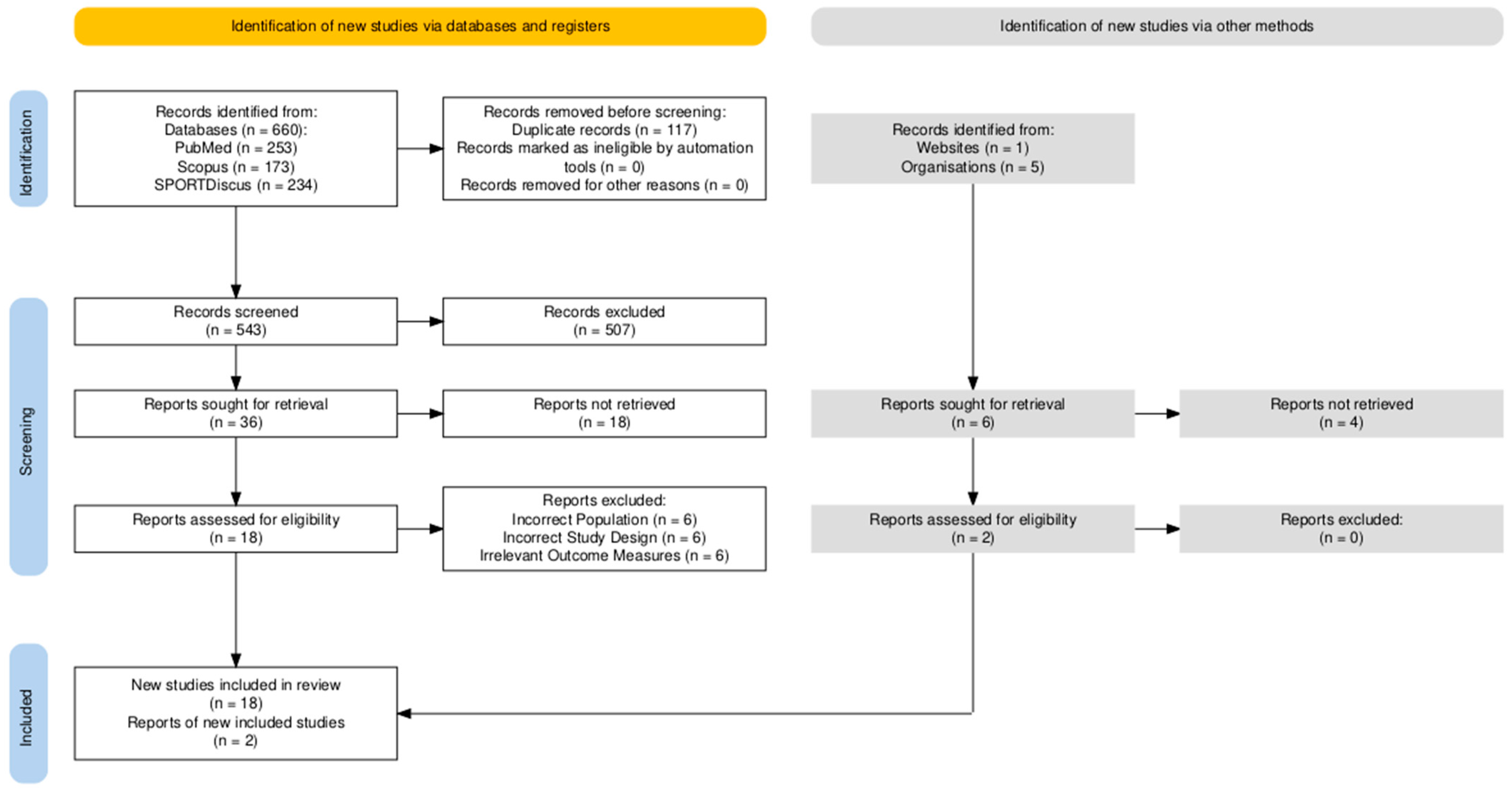
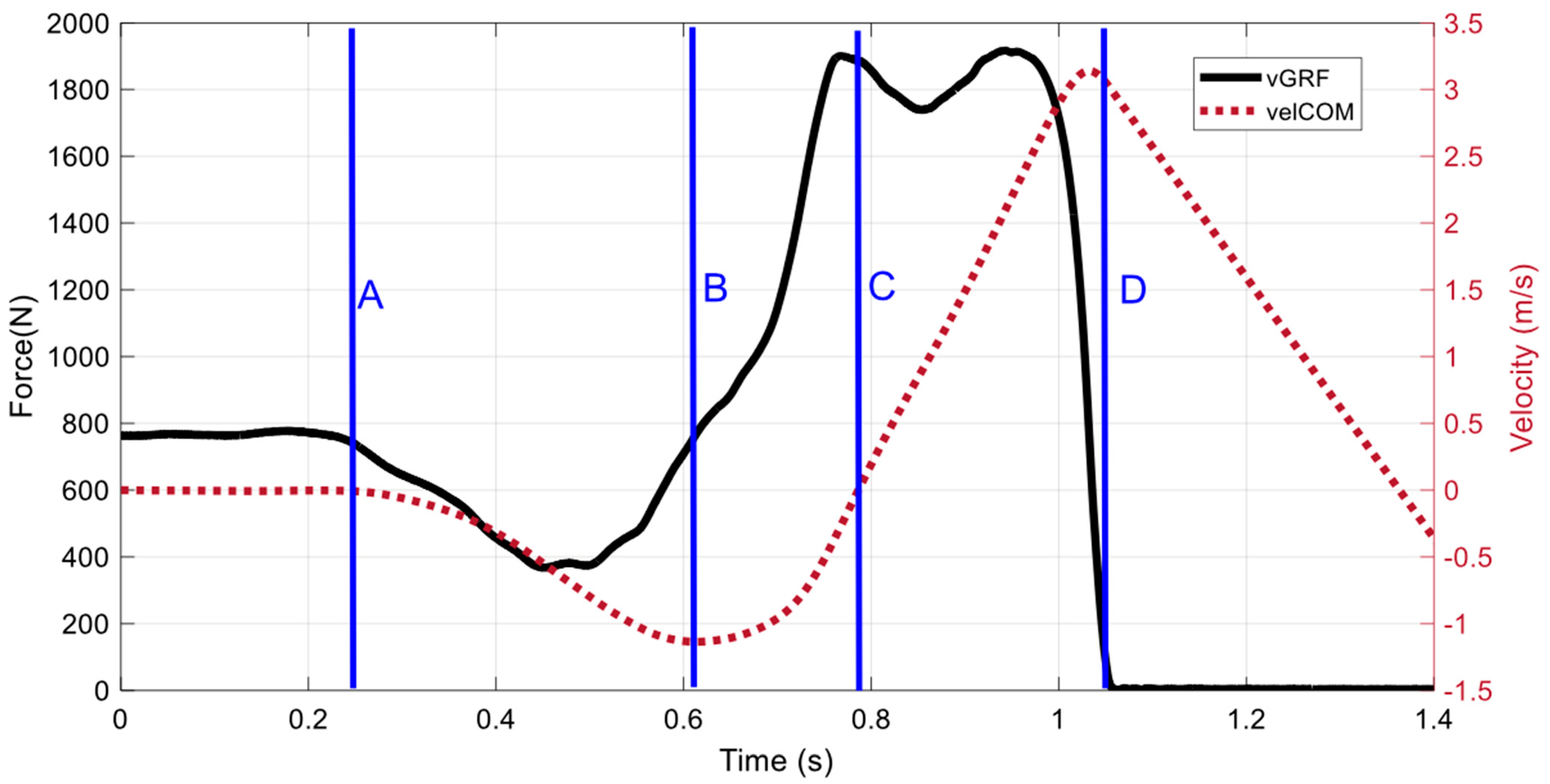
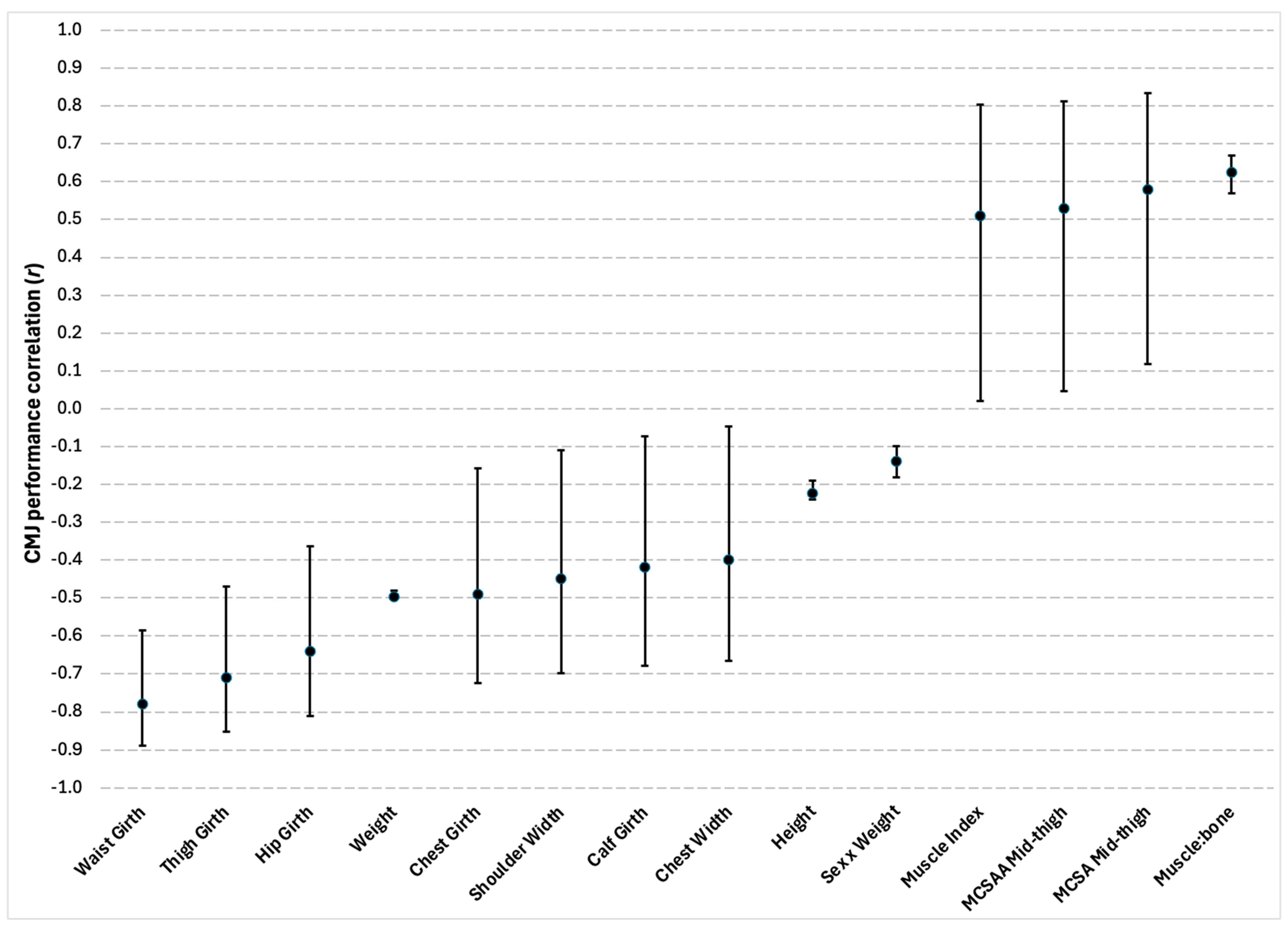
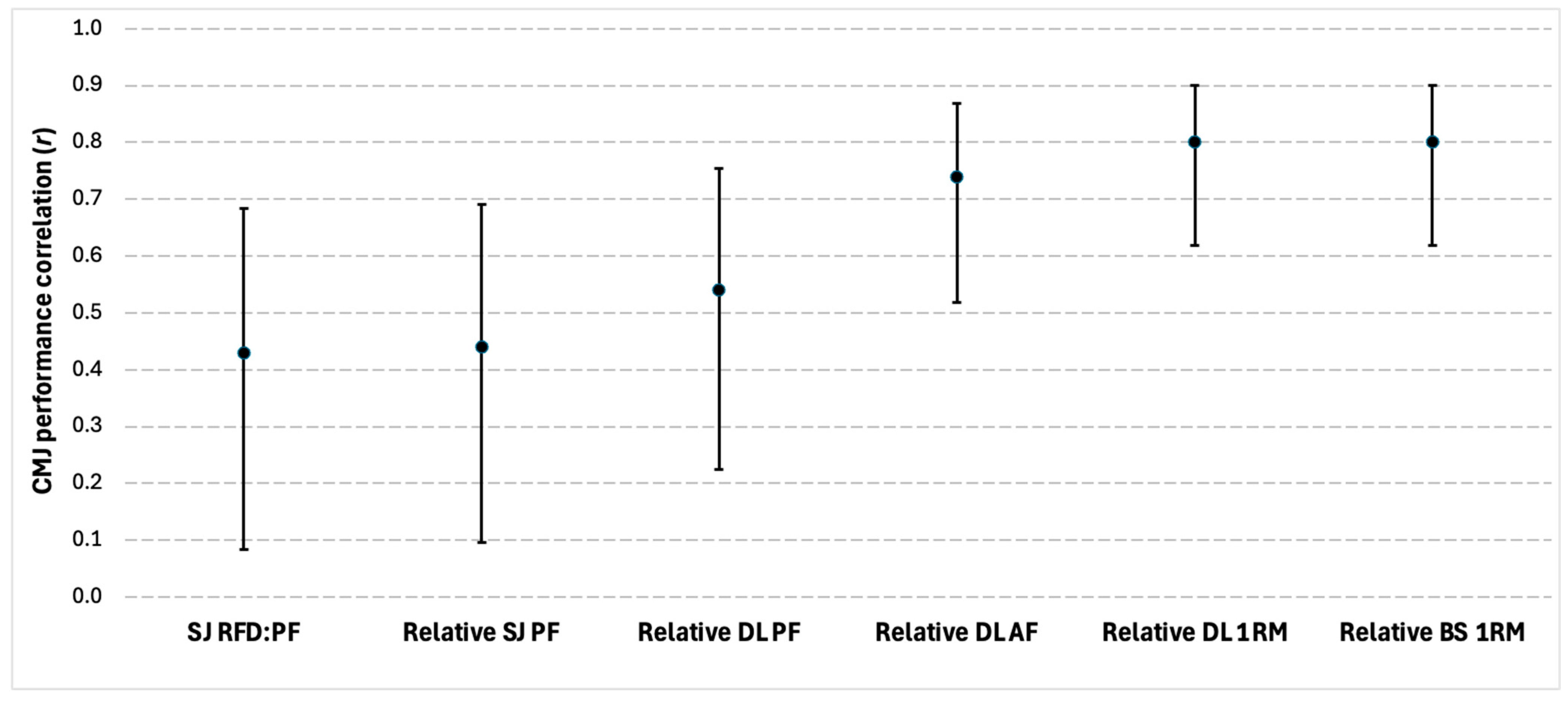
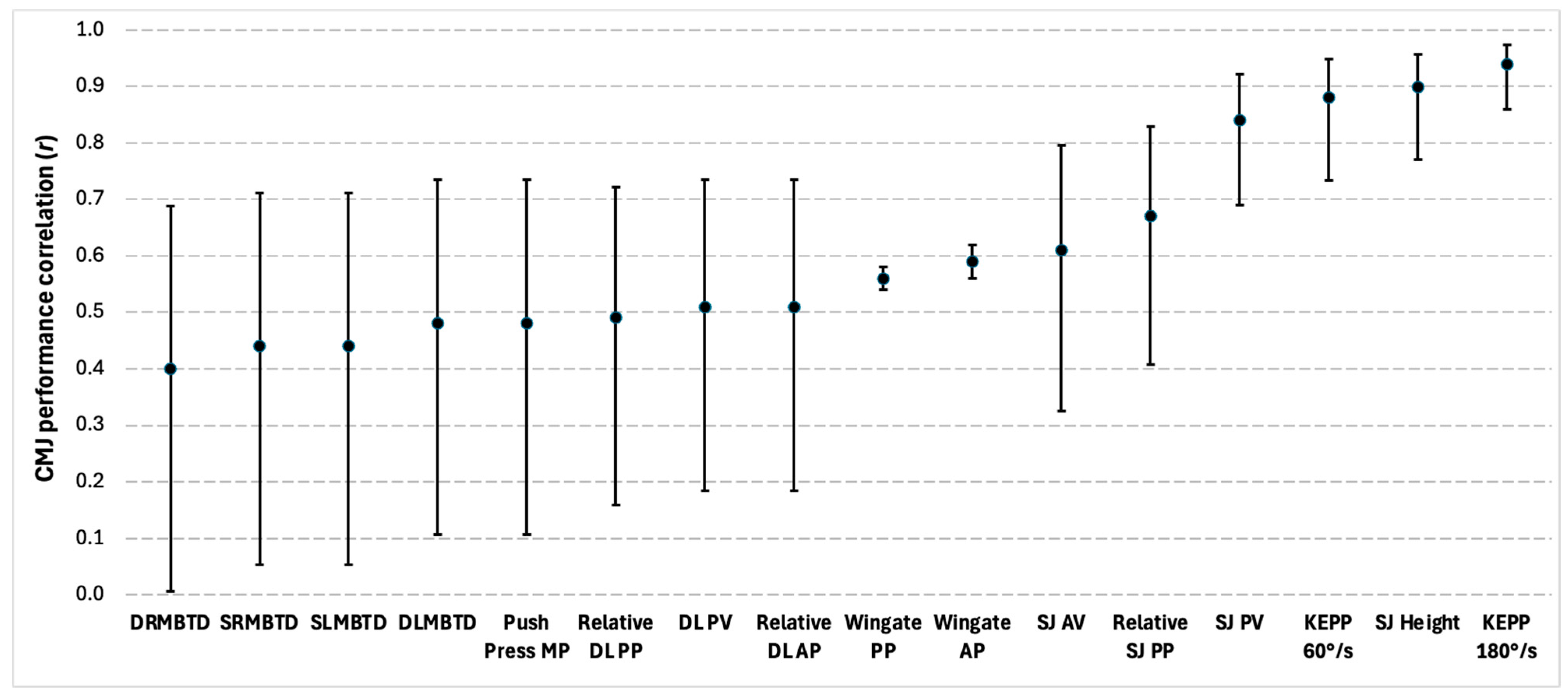
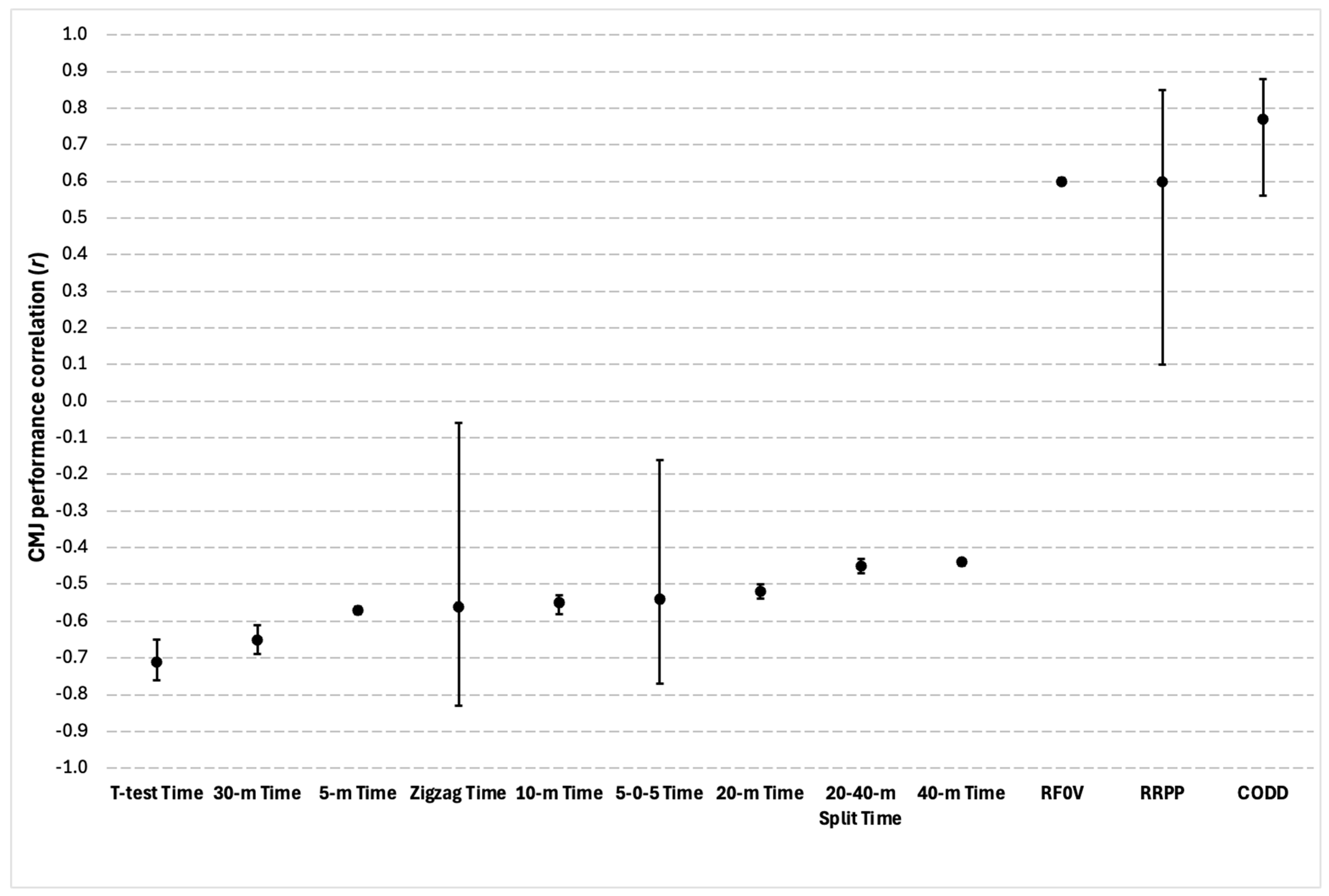
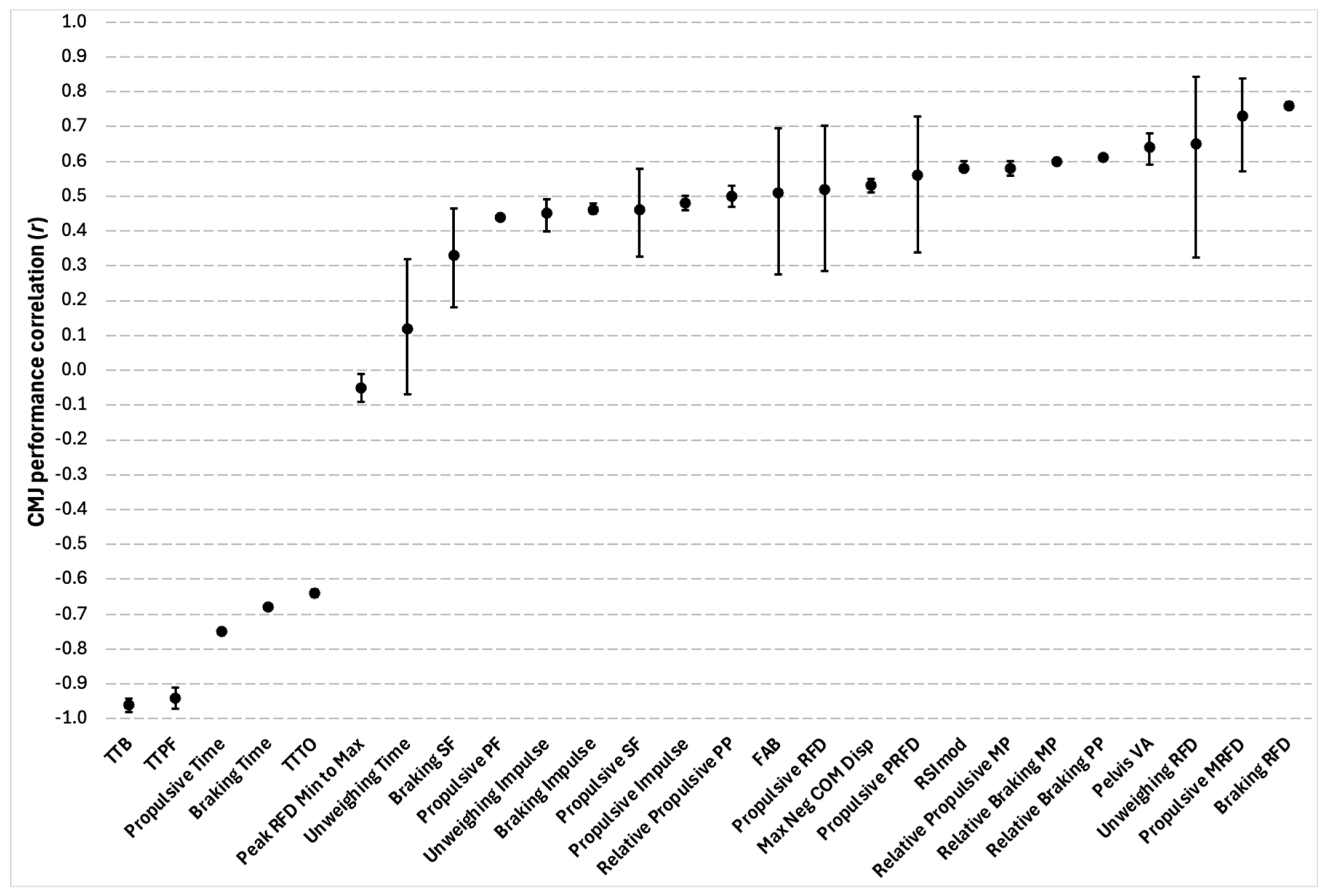
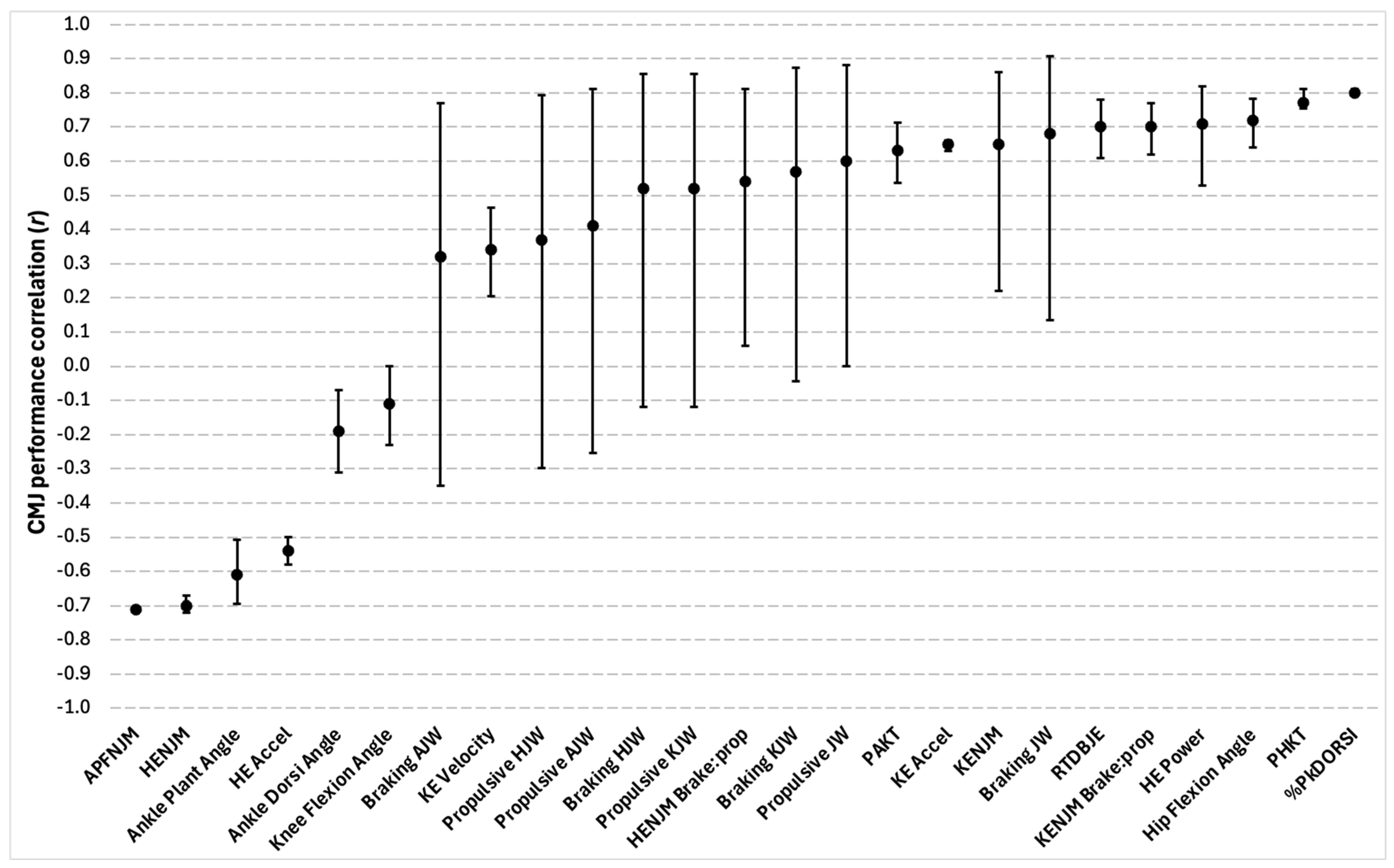
| Study | Question | Total | |||||||
|---|---|---|---|---|---|---|---|---|---|
| 1 | 2 | 3 | 4 | 5 | 6 | 7 | 8 | ||
| Amasay & Suprak, 2010 [39] | Y | Y | Y | Y | Y | N | Y | Y | 88% |
| Brochie et al., 2014 [11] | Y | Y | Y | Y | N | N | Y | Y | 75% |
| Chiu et al., 2014 [12] | Y | Y | Y | Y | N | N | Y | Y | 75% |
| Guess et al., 2020 [38] | N | Y | Y | Y | N | N | Y | Y | 63% |
| Johnston et al., 2015 [40] | Y | Y | Y | Y | Y | Y | Y | Y | 100% |
| Kipp et al., 2020 [49] | Y | Y | Y | Y | Y | Y | Y | Y | 100% |
| Kryszkowski et al., 2022 [50] | N | Y | Y | Y | N | N | Y | Y | 63% |
| Mikołajec et al., 2023 [51] | Y | Y | Y | Y | N | N | Y | Y | 75% |
| Miller et al., 2023 [14] | N | Y | Y | Y | N | N | Y | Y | 63% |
| Morris et al., 2022 [52] | Y | Y | Y | Y | N | N | Y | Y | 75% |
| Pereira et al., 2018 [45] | Y | Y | Y | Y | N | N | N | Y | 63% |
| Rauch et al., 2020 [41] | Y | Y | Y | Y | Y | N | Y | Y | 75% |
| Shalfawi et al., 2014 [53] | Y | Y | U | Y | N | N | U | Y | 50% |
| Shalfawi et al., 2011 [54] | Y | Y | Y | Y | N | N | Y | Y | 75% |
| Shinkle et al., 2012 [55] | Y | Y | Y | Y | N | N | Y | Y | 75% |
| Sole et al., 2018 [42] | Y | Y | Y | Y | N | N | Y | Y | 75% |
| Soslu et al., 2016 [56] | Y | Y | Y | Y | N | N | Y | Y | 75% |
| Swinton et al., 2014 [13] | Y | Y | Y | Y | Y | Y | Y | Y | 100% |
| Average | 76% | ||||||||
| Study | n | Sex | Age (y) | Height (cm) | Weight (kg) | Groups |
|---|---|---|---|---|---|---|
| Amasay & Suprak, 2010 [39] | 49 | NS | 20.2 ± 1.5 | 175.3 ± 8.6 | 73.8 ± 10.6 | NCAA D2 Athletes |
| Brochie et al., 2014 [11] | 16 | M | 26.7 ± 4 | 177 ± 4.3 | 72.1 ± 5.4 | Qatar National Football Team |
| Chiu et al., 2014 [12] | 16 | F | 20.4 ± 1.5 | 178 ± 6 | 70.1 ± 7.1 | NCAA D1 Volleyball Players |
| Guess et al., 2020 [38] | 394 | NS | 18-23 | NS | 74 ± 14.3 | NCAA D1 Athletes |
| Johnston et al., 2015 [40] | 50 | M | 21.7 ± 3.1 | 182 ± 8 | 77.4 ± 9.6 | Competitive Basketball Players |
| Kipp et al., 2020 [49] | 11 | M | 21.6 ± 1.8 | 193.3 ± 10.2 | 80.5 ± 10.5 | NCAA D1 Basketball Players |
| Kryszkowski et al., 2022 [50] | 22 | M | 20 ± 2 | 199 ± 6 | 93.8 ± 7.5 | NCAA D1 Basketball Players |
| Mikołajec et al., 2023 [51] | 15 | NS | 26.9 ± 8.3 | 191 ± 5.3 | 90.7 ± 10 | Polish National 3 × 3 Basketball Team |
| Miller et al., 2023 [14] | 2258 | M and F | 19.8 ± 1.3 | 178.5 ± 7.5 | 80.4 ± 15.8 | NCAA D1 Athletes |
| Morris et al., 2022 [52] | 14 | M | 22.7 ± 3.6 | 188 ± 8 | 88.2 ± 9.4 | Competitive ARF Players |
| Pereira et al., 2018 [45] | 15 | M and F | 28.3 ± 3.2 | 188.3 ± 4.6 | 93.5 ± 8.2 | Brazilian National Handball Teams |
| Rauch et al., 2020 [41] | 178 | M | 23.6 ± 3.7 | 200.3 ± 8 | 99.4 ± 11.7 | NBA Players |
| Shalfawi et al., 2014 [53] | 33 | M | 27.4 ± 3.3 | 192 ± 8.2 | 89.8 ± 11.1 | Norwegian Pro Basketball Players |
| Shalfawi et al., 2011 [54] | 30 | F | 19 ± 4 | 167 ± 4 | 57.5 ± 6.9 | Competitive Norwegian Football Players |
| Shinkle et al., 2012 [55] | 25 | NS | 19 ± 1.1 | 184 ± 4.6 | 106.2 ± 20.9 | NCAA D1 American Football Players |
| Sole et al., 2018 [42] | 150 | M and F | 20.3 ± 1.3 | 175.6 ± 7.3 | 75.1 ± 11.3 | NCAA D1 Athletes |
| Soslu et al., 2016 [56] | 23 | M | 23.2 ± 3.7 | 197.1 ± 9.1 | 95.3 ± 10.5 | NS |
| Swinton et al., 2014 [13] | 30 | M | 24.2 ± 3.9 | 182.4 ± 6.7 | 94.1 ± 12.3 | Competitive Scottish Rugby Players |
| Study | Equipment | Repetitions | Rest | Intensity | Cueing |
|---|---|---|---|---|---|
| Amasay & Suprak, 2010 [39] | Force Plates and Yardstick | 3 | 120 s | 100% | Height and Speed |
| Brochie et al., 2014 [11] | Force Plates | 3 | 20 s | 100% | Height |
| Chiu et al., 2014 [12] | Force Plates and Mo Cap | 4 | NS | 100% | Height |
| Guess et al., 2020 [38] | Force Plates | 2 | NS | 100% | Height and Speed |
| Johnston et al., 2015 [40] | Force Plates and Mo Cap | NS | NS | NS | NS |
| Kipp et al., 2020 [49] | Force Plates and Mo Cap | 2-3 + 2 optional | NS | 25–100% | NS |
| Kryszkowski et al., 2022 [50] | Force Plates | 3 | 120 s | 100% | Height and Speed |
| Mikołajec et al., 2023 [51] | OMD | 3 | NS | 100% | Effort |
| Miller et al., 2023 [14] | Mo Cap | NS | NS | NS | NS |
| Morris et al., 2022 [52] | Force Plates | 3 | 60 s | 100% | Effort |
| Pereira et al., 2018 [45] | Jump Mat | 5 | 15 s | 100% | Effort |
| Rauch et al., 2020 [41] | Force Plates, Yardstick, and Mo Cap | 3 | 90 s | 100% | Effort |
| Shalfawi et al., 2014 [53] | Jump Mat | 2 | 180 s | 100% | Effort |
| Shalfawi et al., 2011 [54] | Force Plates | 2 | 300 s | 100% | Effort |
| Shinkle et al., 2012 [55] | Yardstick | 1 | 180–300 s | 100% | Effort |
| Sole et al., 2018 [42] | Force Plates | 2 | 60 s | 100% | Effort |
| Soslu et al., 2016 [56] | Force Plates | 3 | 30 s | 100% | Height |
| Swinton et al., 2014 [13] | Force Plates | 2 | NS | 100% | Effort |
Disclaimer/Publisher’s Note: The statements, opinions and data contained in all publications are solely those of the individual author(s) and contributor(s) and not of MDPI and/or the editor(s). MDPI and/or the editor(s) disclaim responsibility for any injury to people or property resulting from any ideas, methods, instructions or products referred to in the content. |
© 2025 by the authors. Licensee MDPI, Basel, Switzerland. This article is an open access article distributed under the terms and conditions of the Creative Commons Attribution (CC BY) license (https://creativecommons.org/licenses/by/4.0/).
Share and Cite
Bygate-Smith, M.K.; Beaven, C.M.; Drury, M. Physical and Biomechanical Relationships with Countermovement Jump Performance in Team Sports: Implications for Athletic Development and Injury Risk. Sports 2025, 13, 277. https://doi.org/10.3390/sports13080277
Bygate-Smith MK, Beaven CM, Drury M. Physical and Biomechanical Relationships with Countermovement Jump Performance in Team Sports: Implications for Athletic Development and Injury Risk. Sports. 2025; 13(8):277. https://doi.org/10.3390/sports13080277
Chicago/Turabian StyleBygate-Smith, Moses K., C. Martyn Beaven, and Mark Drury. 2025. "Physical and Biomechanical Relationships with Countermovement Jump Performance in Team Sports: Implications for Athletic Development and Injury Risk" Sports 13, no. 8: 277. https://doi.org/10.3390/sports13080277
APA StyleBygate-Smith, M. K., Beaven, C. M., & Drury, M. (2025). Physical and Biomechanical Relationships with Countermovement Jump Performance in Team Sports: Implications for Athletic Development and Injury Risk. Sports, 13(8), 277. https://doi.org/10.3390/sports13080277







